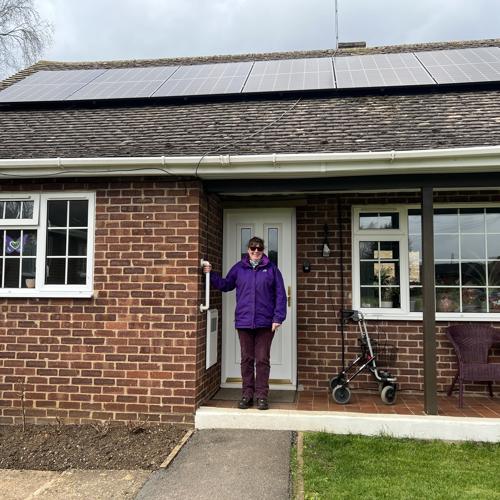What is retrofitting? Sadly (or maybe not depending on your taste) it's not about going back to the swinging sixties and putting on a pair of flares and a flower-power t-shirt. Instead, retrofitting is simply the process of making energy improvements to your home. Sounds a bit groovy, right?
The aim of retrofitting is to make your home warmer and cheaper to heat, and as your landlord, we're here to offer more than just a helping hand. Over the last few years we've been granted funding to retrofit a growing number of your homes. This means there's no cost at all to customers and we and our contractors take care of any work.
There are loads of energy saving measures out there and we know some of their names may leave you wondering what on earth are we talking about. So, we're here to break it down for you. At the bottom of this page is an A-Z of all the different energy efficiency measures and simple explanations of what they are, so you'll be a retrofitting wizard in no time. Don't worry, we won't be quizzing you on your knowledge!
We work with two main contractors to complete these works, Coactivation and SBS (Sustainable Building Services). Head to their websites to find out more about them.
If there's anything not covered on this page please visit our FAQ page for more information.
And if there's anything you'd like to ask us, no matter how big or small the query, just drop us an email at sustainability@futureshg.co.uk - please make sure you include your full name and address!
News and updates
All the latest news on the world of retrofitting, sustainability and all things green at Futures. Read more here.
Case study: Hear from one of our customers

Lucille's solar panels
Lucille has had several energy saving measures fitted to her property over the last few years. Most recently she had solar panels installed, so we listened to her experiences of the whole process and what she'd recommend to those offered any energy efficiency works.
Click here to read Lucille's story in fullA - Z of energy efficiency measures
Air-to-air heat pump
Air-to-air heat pumps transfer heat from the air outside air to the air in your home. This increases the temperature of the air in each room.
- These heat pumps don't heat your water so you will need another heating system for hot water.
- Your home will need enough outside space for the heat pump to be installed.
- How much you can save on your energy bill depends on various factors, such as your previous heating, how well insulated your home is and how the heat pump is used.
Air source heat pump
Air source heat pumps (ASHPs) sometimes called air-to-water source heat pumps, transfer heat from the outside air to water, which is then used to heat your home through radiators or underfloor heating. It can also heat up your hot water cylinder unlike and air-to-air heat pump.
- Compared to gas boilers, ASHPs work best at low temperatures and should be installed in well-insulated homes.
- ASHPs need enough indoor and outdoor space to install the heat pump and hot water cylinder.
- How much you can save on your energy bill depends on various factors, such as your previous heating, how well insulated your home is and how the heat pump is used.
Cavity wall insulation
Most homes built from 1930s onwards have cavity walls. A cavity wall is made up of two walls (the inner and outer wall of your home) with a gap between them - the cavity. Heat can escape from your home through this gap - but filling the cavity with insulation can slow or stop heat from escaping.
- Insulation can be injected into the cavity by drilling holes which are then sealed with cement.
- The insulation material is usually either mineral wool or polystyrene beads.
Draught-proofing
A draughty home is not just uncomfortable, but also lets expensive heat out and cold air in. Draught-proofing can reduce or stop these air leaks and can be done by professionals or even simple DIY projects.
- Most homes, particularly older ones, have cracks and gaps through which warm air escapes and cold air blows in.
- Simple DIY jobs with products you can buy off-the shelf can help reduce or eliminate many of these heat-leaking gaps, such as those in floorboards and around windows, doors, letterboxes, pipework and your loft hatch.
- Do be aware though that you don't want your home to be completely airtight. You do need some ventilation, particularly to help let out moisture in the air and avoid problems with damp and mould. So please don't block up any vents - such as those installed in uPVC windows - as they have an important job to do. See the ventilation section below for more information about this.
External wall insulation
External wall insulation adds a layer of insulating material to the outside of your home which is then covered up with a protective render or cladding.
- It's usually installed onto solid wall properties, commonly built before 1920.
- After installation, the outside of your home will need redecorating. This will be done by professionals and you will have some choice about colours and finishes.
- The installation process can be disruptive with things like electricity cables to consider, but it can help your home feel warmer and help reduce your energy bills.
Ground source heat pump
Even on the coldest days, the temperature below ground is quite stable and there is 'hidden' heat that can be used to warm up your home and hot water. A ground source heat pump (GSHP) transfers that heat to into your home to heat rooms and water in your a hot water cylinder.
- This type of heat pump is more expensive and disruptive to install than air source and air-to-air heat pumps as pipes have to be installed underground. This also means that more space is needed outside to install them.
- GSHPs also work best in well insulated homes and at lower temperatures. Like other heat pumps, bill savings depend on how big the property is and the previous heating system.
Loft insulation
Loft insulation means adding insulating material inside the roof space of your home to stop heat from escaping. It can be installed in any home where there is space between the ceiling and outer room and is usually this made from mineral wool, fibreglass or sheep's wool.
- Installation should make your home feel warmer and stay warmer for longer, which means your energy bills should lower too.
- The insulation only takes a few hours to install and can last for up to 40 years!
Solar photovoltaic (PV) panels
Solar (PV) panels capture the sun’s energy and convert it into electricity. They don’t need direct sunlight to work and can even work on cloudy days. However, the stronger the sunshine, the more electricity generated.
- Did you know you can sell surplus energy back to the grid? In terms of Energy Performance Certificates (EPC), solar PV is rated a better energy efficiency measure than solar thermal.
Solar thermal panels
Solar thermal panels capture the sun’s energy to create heat for domestic hot water. In the summer, they can meet all or most of your hot water needs.
- This is an older technology than solar (PV) panels, but they can provide benefits depending on how much hot water is used, the direction the roof faces and existing insulation of your home.
Ventilation
Ventilation may seem counterproductive to draught-proofing, but it's still important to have air flow through your home. It keeps your home fresh, dry and healthy and can help reduce the risk of damp and mould.
- Ideally it'd be great to have some ventilation in all rooms, but your kitchen and bathroom is where it's most needed.
- Extractor fans can remove damp air quickly so they're recommended for kitchens and bathrooms.
- Other types of ventilation are openable windows, wall vents and trickle vents (small vents above a window).
Windows and doors
Homes can lose around 10-20% of their heat through windows and external doors, so having double glazed windows and thermally efficient doors can help reduce this heat loss.
- Energy efficient windows are usually double glazed. The gap between the two panes of glass can be filled with a safe gas, such as argon, to help further reduce heat loss.
- High performance thermal doors can be solid, partially glazed or fully glazed and made out of uPVC, aluminium, timber or even a combination of these materials.
- If they are partially or fully glazed, then these doors are either double or triple glazed, with argon gas in between the glass panes to stop heat passing through.
- Modern doors do tend to be better insulated and fit much more tightly into the door frame, which reduces draughts.


















